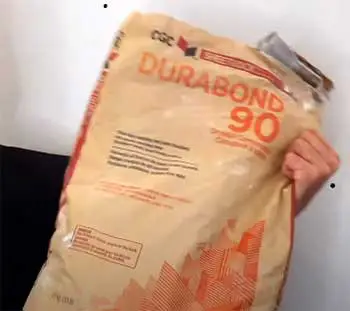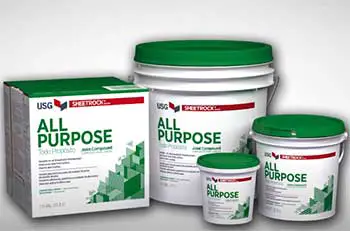When choosing reliable home repair projects, choosing the right wall-patching putties is vital to making your task successful. Since both Durabond and Joint Compound are high-quality products, selecting either option may seem tricky and confusing.
However, they have their own unique formula. Hence, many specifications will set them apart.
Here, we will go for in-depth details between Durabond and Joint Compound to help you decide the best option for your home repair project. Let’s start without further ado!
A Quick Comparison Table
Interested in learning about these wall-patching putties quickly? Here is a small table to help you learn to have some brief ideas about both of them.
| Specification | Durabond | Joint Compound |
| Ingredients | Calcium Sulfate Hemihydrate and minerals | Limestone, gypsum, and other materials. |
| Ideal usage | Finish gypsum panel joints, skim coating, trim and fasteners, corner bead, etc. | Smoothing, filling, concrete ceilings, sound-deadening boards, above-grade concrete surfaces, etc. |
| Types | Durabond 20, 45, 90, 210 | All-purpose, Topping, Taping, Quick-setting |
| Bond strength | Higher bond strength | Decent bond strength |
| Formula | Available only in powder versions | Available in pre-mixed and powder version |
| Drying Time | 24 hours to 48 hours | Up to 24 hours |
| Minimum coats | At least two coats | At least three to five coats |
| Costs | More affordable | A slightly pricey |
Main Differences Between Durabond And Joint Compound
Is the above comparison table enough to decide the best wall-patching putties?
There are many technical details about them, which is crucial to choosing the best possible decisions. Below, we mention some important factors of both products to learn them in-depth.
- Ingredients

Ingredients are one of the critical factors that will set apart both wall-patching putties from each other.
Durabond is made of primarily calcium Sulfate Hemihydrate, minerals, and other few ingredients.
The inclusion of Calcium Sulfate Hemihydrate in Durabond makes the coat super hard once they dry properly.
On the contrary, Joint Compounds are made of limestone, gypsum, and other materials.
Limestone is mainly a natural building material that is fire and heat-resistant. It ensures long-lasting durability.
Also, you don’t need to worry about color fading issues since limestone is resistant to UV radiation. Plus, gypsum allows you to achieve a smooth wall surface.
- Ideal usage
Both building materials are highly versatile to use in a wide range of areas. But they have their own specifications.
For instance, Durabond can be used on finish gypsum panel joints, skim coating, trim & fasteners, corner beads, exterior gypsum ceiling boards, veneer plaster finish, etc.
On the other hand, joint compounds are ideal for smoothing, filling concrete ceilings, sound-deadening boards, above-grade concrete surfaces, etc.
- Types
Durabond is available in various types, such asDurabond 20, 45, 90, and 210. Each has a particular drying time and is ideal to use on a specific surface.
For instance, Durabond 45 has a set time of 30-80 minutes and is suitable for drywall interiors and exteriors.
On the contrary, joint compounds are also available in the all-purpose, topping, taping, and quick-setting options.
If you are in the market for a highly versatile joint compound, use the all-purpose version. The topping type is mainly ideal for final coating and requires you to apply a minimum of two coats.
- Bond strength
Before choosing a particular building material, you must decide how much bond strength you need. Compared to joint compounds, Durabond has higher bond strength.
However, both versions have immense durability if you can apply them correctly.
- Formula
Which version do you prefer: powder or pre-mixed? Powder versions are better when you work on small projects regularly. So, you just add the required amount you need.
On the contrary, pre-mixed versions are ideal for large projects when you want to save time. Durabond is mainly available in powder versions, while joint compounds are available in powder and ready-to-use versions.
- Drying Time

It is vital to the drying time of building material.
This will help you have a better calculation to work on the particular home task accordingly.
Joint compounds dry quickly.
They generally take 12-24 hours to dry. But 24 hours is always recommended.
On the contrary, Durabond takes a little time to dry, and its drying time can be 24 hours or 48 hours.
However, drying time often depends on how you apply them and, more importantly, the humidity and temperature conditions.
Compared to joint compounds, Durabond becomes very hard once they dry properly.
- Minimum Coats
Applying a minimum of 3 to 5 coats is necessary for joint compounds. Their formula is not extremely heavy. Plus, they dry quickly.
In contrast, Durabond has a heavy formula, and it is often okay to apply only two coats. But in a few cases, you may need extra coats based on the home building project you handle.
- Costs
The per-pound cost of Durabond is lower than the joint compound. However, you need to purchase a bulk quantity while buying Durabond.
Though joint compounds have a higher price tag, they are available in small amounts than Durabond.
Uses for Durabond
Thanks to its unmatched strength and quick-hardening abilities, Durabond has many important uses during drywall installation and repair:
- Embedding tape – The fast initial grab and strength make Durabond ideal for setting paper tape over seams and corners. Much stronger than air-drying options.
- Filling cracks – It won’t shrink into cracks as it dries, allowing you to fill even wide gaps solid. Keys for crack repair success.
- Quick fixes – Knocks a hole in the wall that needs patching before a house showing? Mix some 5-minute Durabond! Its rapid solve time can’t be matched.
- Preventing nail pops – Smashed flakes between drywall sheets help stiffen the area around nails to prevent future popping.
- High strength areas – Anywhere needing an extra durable finish – high traffic halls, kids rooms, garages, etc – Durabond is made for the job.
While it can technically be used for finish coating, Durabond really shines for embedding tape, repairs, and high strength areas as outlined above. Other muds finish sand much easier.
Uses for Joint Compound
On the other hand, versatile joint compound is designed for overall wall finishing:
- Finish coats – Multiple smooth layers are easily sanded for a blemish-free surface ready for priming and paint. A necessity for properly finished drywall.
- Skim coating – Thin skim layers fill uneven drywall surfaces to create flawlessly smooth results unachievable with sanding alone.
- Corner beads – Paper faced metal corner bead strips embed easily into joint compound for durable, straight corners.
- Texture – Joint compound is easily sprayed or troweled to mimic any pattern imaginable – knockdown, popcorn, orange peel, etc.
If you need to hide drywall seams, finish corners, or coat entire walls, you can’t go wrong with trusted joint compound. Tap and finish out repairs with fast-setting Durabond when needed.
What Will Be The Suitable Choice For Your Home?

Both Durabond and joint compound are pretty versatile to use in a wide range of surfaces in our home building projects.
Though they have their own purposes, you can use either of them in some cases.
If you are handling a massive home building project, Durabond appears an ideal choice since it comes in larger quantities and affordable price.
But joint compounds appear the best choice for small projects because you don’t need too bulky options.
Frequently Asked Questions (FAQs)
Though both can be used for alternative purposes, they have their own specifications that set them apart from each other.
You can use Durabond for different purposes such as finish gypsum panel joints, skim coating, trim & fasteners, corner beads, exterior gypsum ceiling boards, veneer plaster finish, etc.
It depends on the project you handle. Since joint compounds create thinner coats than Durabond, you can use them over Durabond in some cases to create a finish coat.
You can sand Durabond before they become entirely dry. Once they become fully dry, they will be hard to sand.
Final Thought
So, which option have you decided to choose between Durabond vs. Joint Compound? No doubt, both building materials are highly durable and super versatile to use on various wall surfaces.
But you must first determine your home building projects and choose a particular one based on the information we have outlined above.
